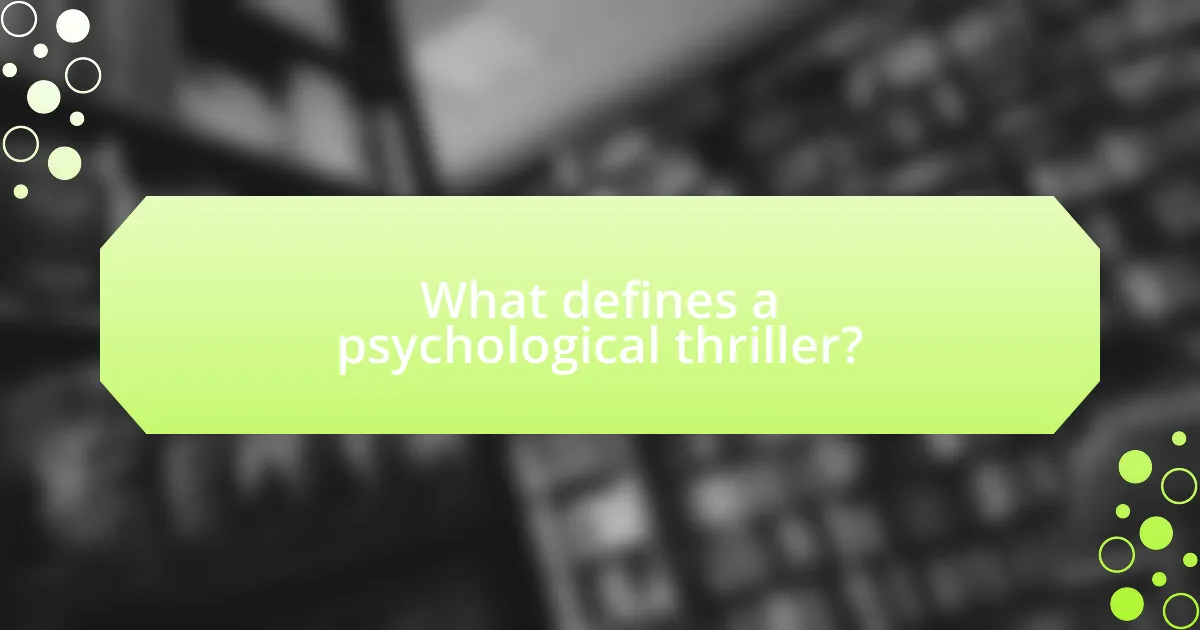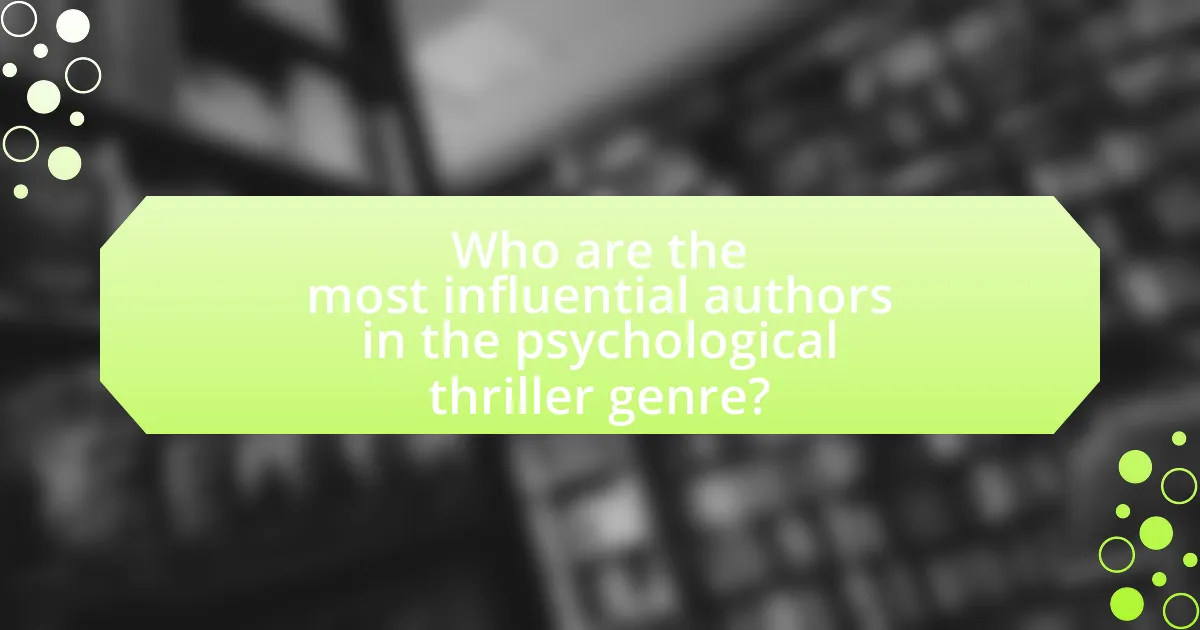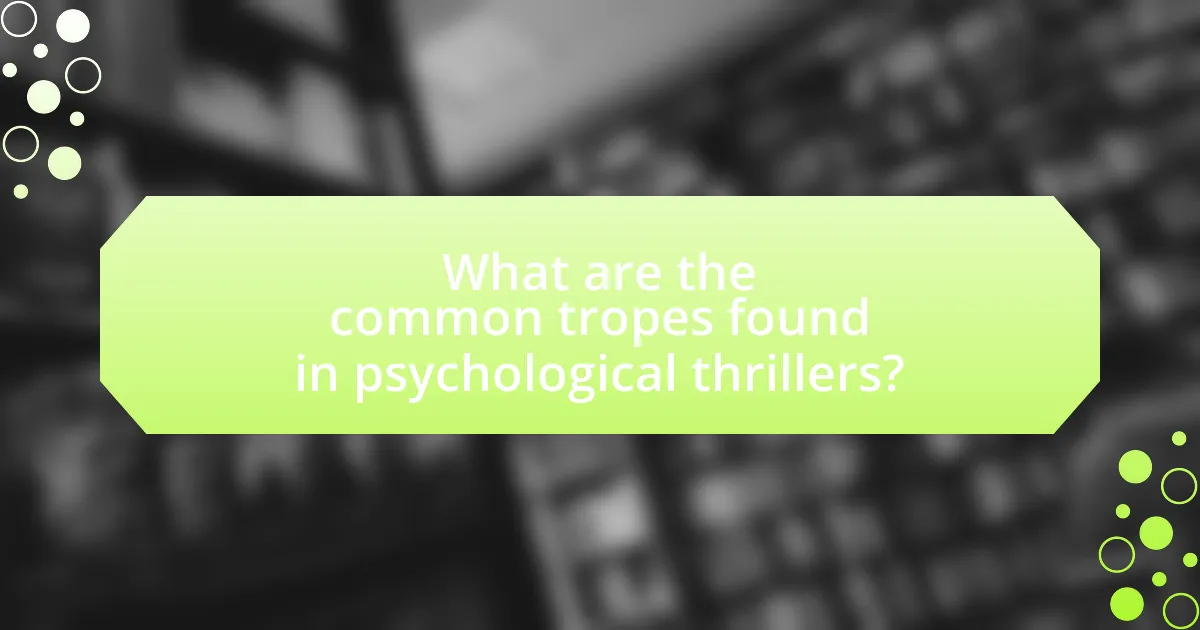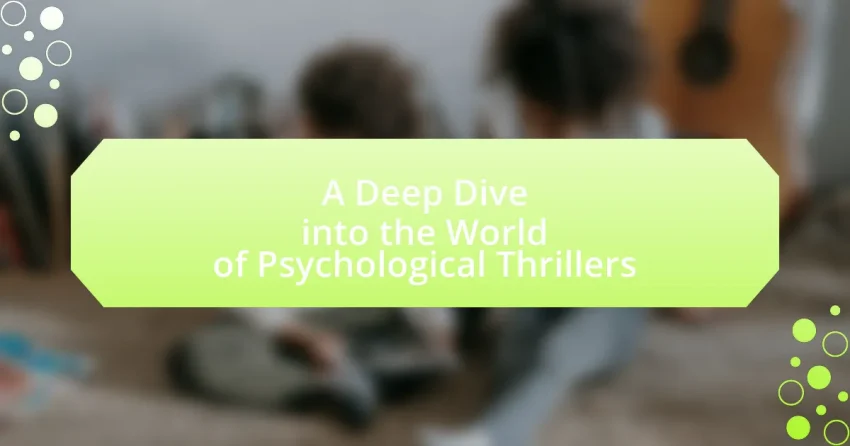Psychological thrillers are a genre characterized by their exploration of the mental and emotional states of characters, focusing on themes such as paranoia, obsession, and the complexities of the human psyche. This article provides an in-depth examination of psychological thrillers, highlighting their key elements, differences from other genres, and the themes commonly explored, such as identity and manipulation. It also discusses the influence of notable authors like Gillian Flynn and Patricia Highsmith, the role of mental illness, and current trends shaping the genre, including the impact of technology and narrative techniques like unreliable narrators and foreshadowing. Additionally, the article offers insights into effective writing strategies for creating compelling psychological thrillers that resonate with readers.

What defines a psychological thriller?
A psychological thriller is defined by its focus on the mental and emotional states of its characters, often exploring themes of paranoia, obsession, and the complexities of the human psyche. This genre typically emphasizes suspense and tension derived from the characters’ psychological struggles rather than external action or violence. Notable examples include works like “Gone Girl” by Gillian Flynn, which delves into manipulation and deceit, illustrating how psychological elements drive the narrative and engage the audience.
How does a psychological thriller differ from other genres?
A psychological thriller differs from other genres primarily through its focus on the mental and emotional states of characters, often exploring themes of paranoia, obsession, and the complexities of the human psyche. Unlike traditional thrillers that may emphasize action or physical danger, psychological thrillers delve into the internal struggles and motivations of characters, creating tension through psychological conflict rather than external threats. This genre often employs unreliable narrators and intricate plot twists to challenge the audience’s perception of reality, as seen in works like “Gone Girl” by Gillian Flynn, which intricately weaves psychological manipulation into its narrative.
What are the key elements that characterize psychological thrillers?
Psychological thrillers are characterized by elements such as complex characters, intense emotional conflict, and a focus on the psychological states of the characters. These narratives often explore themes of manipulation, paranoia, and the fragility of the human mind, creating suspense through the characters’ internal struggles rather than external action. For instance, films like “Gone Girl” and “Black Swan” exemplify these traits by delving into the protagonists’ psychological turmoil and moral ambiguity, which heightens tension and engages the audience on a deeper emotional level.
Why do psychological thrillers captivate audiences?
Psychological thrillers captivate audiences due to their ability to evoke intense emotional responses and provoke deep psychological engagement. These narratives often explore complex characters and intricate plots that challenge viewers’ perceptions of reality, morality, and human behavior. Research indicates that the suspense and unpredictability inherent in psychological thrillers stimulate the brain’s reward system, releasing dopamine and enhancing viewer enjoyment. Additionally, the genre’s focus on psychological tension allows audiences to confront their fears and anxieties in a safe environment, making the experience both thrilling and cathartic.
What themes are commonly explored in psychological thrillers?
Psychological thrillers commonly explore themes of identity, manipulation, and the fragility of sanity. These narratives often delve into the complexities of the human mind, showcasing characters who grapple with their own perceptions and realities. For instance, the theme of identity is frequently examined through characters who experience dissociative disorders or undergo significant transformations, leading to questions about who they truly are. Manipulation is another prevalent theme, where characters engage in psychological games, often resulting in betrayal and deceit. Additionally, the fragility of sanity is highlighted as characters confront their fears, traumas, and moral dilemmas, leading to intense psychological conflict. These themes are supported by numerous works in the genre, such as “Gone Girl” by Gillian Flynn, which intricately weaves these elements into its plot, demonstrating their significance in psychological thrillers.
How do themes of obsession and manipulation manifest in these stories?
Themes of obsession and manipulation manifest in psychological thrillers through characters who exhibit intense fixation on others, often leading to controlling behaviors. For instance, in “Gone Girl” by Gillian Flynn, the protagonist’s obsession with her husband drives her to orchestrate an elaborate scheme to manipulate public perception and control his life. This manipulation is evident when she stages her own disappearance, showcasing how obsession can lead to extreme actions that disrupt relationships and societal norms. Similarly, in “Fatal Attraction,” the character Alex Forrest’s obsessive love for Dan Gallagher escalates into dangerous manipulation, as she employs deceit and intimidation to maintain her grip on him. These narratives illustrate how obsession can distort reality and lead to destructive outcomes, highlighting the psychological complexities inherent in such relationships.
What role does mental illness play in psychological thrillers?
Mental illness serves as a central theme in psychological thrillers, often driving the plot and character development. Characters with mental health issues frequently embody complex motivations and unpredictable behaviors, which create tension and suspense. For instance, films like “Fight Club” and “Black Swan” illustrate how mental illness can lead to distorted realities and moral ambiguity, enhancing the psychological depth of the narrative. Research indicates that the portrayal of mental illness in media can influence public perception, often perpetuating stereotypes, yet it also provides a lens through which audiences can explore the intricacies of the human psyche.

Who are the most influential authors in the psychological thriller genre?
The most influential authors in the psychological thriller genre include Gillian Flynn, Patricia Highsmith, and Stephen King. Gillian Flynn’s novel “Gone Girl” redefined the genre with its unreliable narration and complex characters, becoming a bestseller and a cultural phenomenon. Patricia Highsmith is renowned for her psychological depth and moral ambiguity, particularly in her “Tom Ripley” series, which has influenced countless writers. Stephen King, while primarily known for horror, has made significant contributions to psychological thrillers with works like “Misery,” showcasing the psychological torment of characters. These authors have shaped the genre through their innovative storytelling and exploration of the human psyche.
What are the signature styles of notable psychological thriller authors?
Notable psychological thriller authors exhibit distinct signature styles that define their narratives. For instance, Gillian Flynn is known for her unreliable narrators and intricate character development, particularly in “Gone Girl,” where the dual perspectives create tension and ambiguity. Similarly, Paula Hawkins employs a fragmented narrative structure in “The Girl on the Train,” which enhances the theme of memory and perception. Additionally, Stephen King often blends horror with psychological elements, as seen in “Misery,” where isolation and obsession drive the plot. These authors utilize techniques such as unreliable narration, complex character arcs, and non-linear storytelling to engage readers and evoke psychological tension.
How have these authors shaped the genre over time?
These authors have significantly shaped the psychological thriller genre by introducing complex characters and intricate plots that explore the human psyche. For instance, Alfred Hitchcock’s films, such as “Psycho,” revolutionized suspense and psychological tension, influencing countless filmmakers and writers. Similarly, Patricia Highsmith’s novels, particularly “Strangers on a Train,” introduced morally ambiguous characters and themes of obsession, which have become staples in the genre. Furthermore, authors like Gillian Flynn, with her bestseller “Gone Girl,” have modernized the genre by incorporating unreliable narrators and social commentary, reflecting contemporary societal issues. Collectively, these contributions have established psychological thrillers as a rich and evolving genre that continues to captivate audiences.
What are some must-read works by these authors?
Must-read works by authors in the psychological thriller genre include “Gone Girl” by Gillian Flynn, which explores themes of deception and media influence, and “The Girl on the Train” by Paula Hawkins, known for its unreliable narrator and intricate plot twists. Additionally, “The Silent Patient” by Alex Michaelides captivates readers with its psychological depth and unexpected revelations. These works are significant as they have garnered critical acclaim and commercial success, often being featured in bestseller lists and adapted into films, thus validating their impact on the genre.
How do psychological thrillers evolve in modern literature?
Psychological thrillers in modern literature evolve through the integration of complex character development, intricate plots, and contemporary themes that reflect societal anxieties. Authors increasingly focus on the psychological depth of characters, often blurring the lines between protagonist and antagonist, which enhances the suspense and emotional engagement. For instance, works like “Gone Girl” by Gillian Flynn and “The Girl on the Train” by Paula Hawkins showcase unreliable narrators and explore themes of obsession and betrayal, resonating with current societal issues such as mental health and gender dynamics. This evolution is marked by a shift from traditional suspense to a more nuanced exploration of the human psyche, reflecting the changing landscape of reader expectations and cultural conversations.
What trends are currently shaping the psychological thriller landscape?
Current trends shaping the psychological thriller landscape include the rise of unreliable narrators, the exploration of mental health themes, and the integration of technology in storytelling. Unreliable narrators create suspense and challenge readers’ perceptions, as seen in works like “Gone Girl” by Gillian Flynn. The focus on mental health reflects societal awareness, with narratives often delving into psychological disorders, as exemplified by “The Silent Patient” by Alex Michaelides. Additionally, technology’s role in plot development, such as social media and surveillance, enhances tension and relevance, evident in titles like “The Girl on the Train” by Paula Hawkins. These trends collectively reflect evolving reader interests and societal issues, driving the genre’s innovation and engagement.
How has technology influenced the storytelling in psychological thrillers?
Technology has significantly influenced storytelling in psychological thrillers by enhancing narrative complexity and character development through digital mediums. The integration of social media, smartphones, and surveillance technology allows for intricate plots that explore themes of paranoia, identity, and reality. For instance, films like “Unfriended” utilize real-time online interactions to create suspense, while series like “Black Mirror” examine the psychological implications of technology on human behavior. These advancements enable creators to craft multi-layered stories that reflect contemporary anxieties, making the genre more relevant and engaging for audiences.

What are the common tropes found in psychological thrillers?
Common tropes found in psychological thrillers include unreliable narrators, where the protagonist’s perspective is distorted, creating doubt about their truthfulness. Another prevalent trope is the exploration of the human psyche, often delving into themes of obsession, paranoia, and mental illness. Additionally, plot twists are frequently employed to subvert audience expectations, enhancing suspense. The presence of a cat-and-mouse dynamic between the protagonist and antagonist is also typical, heightening tension. These elements are essential in crafting narratives that engage and challenge viewers, making psychological thrillers compelling and thought-provoking.
How do unreliable narrators enhance the psychological tension?
Unreliable narrators enhance psychological tension by creating ambiguity and uncertainty in the narrative. This narrative device forces readers to question the truthfulness of the narrator’s perspective, leading to heightened suspense and emotional engagement. For instance, in novels like “Gone Girl” by Gillian Flynn, the dual perspectives of the protagonists reveal conflicting truths, which keeps readers on edge as they attempt to discern reality from deception. This manipulation of perception not only deepens the psychological complexity of the characters but also amplifies the overall tension within the story, as readers grapple with the implications of unreliable information.
What are the effects of plot twists on reader engagement?
Plot twists significantly enhance reader engagement by creating surprise and altering expectations. These unexpected turns in the narrative compel readers to reevaluate their understanding of the story, fostering a deeper emotional investment. Research indicates that plot twists can increase the level of suspense and intrigue, making readers more likely to continue reading to resolve the tension created. For instance, a study published in the journal “Psychological Science” by researchers at the University of California found that unexpected plot developments can lead to heightened emotional responses, thereby increasing overall enjoyment and engagement with the text.
How do settings contribute to the overall atmosphere of psychological thrillers?
Settings significantly contribute to the overall atmosphere of psychological thrillers by establishing mood, tension, and emotional resonance. For instance, dark, isolated locations can evoke feelings of fear and paranoia, while urban environments may create a sense of chaos and unpredictability. The use of atmospheric elements, such as weather conditions or architectural styles, enhances the psychological tension by reflecting characters’ internal struggles. Research indicates that settings in psychological thrillers often serve as a character themselves, influencing plot development and audience perception, as seen in works like “Gone Girl” by Gillian Flynn, where the suburban backdrop amplifies themes of deception and domesticity.
What techniques do authors use to build suspense in psychological thrillers?
Authors build suspense in psychological thrillers through techniques such as foreshadowing, unreliable narrators, and pacing. Foreshadowing creates anticipation by hinting at future events, which keeps readers engaged and guessing. Unreliable narrators distort reality, leading readers to question the truth and heightening tension. Pacing, often manipulated through short chapters or cliffhangers, maintains a sense of urgency and keeps readers on edge. These techniques are effective because they exploit psychological tension and emotional investment, making the reader feel a sense of impending danger or revelation.
How does pacing affect the reader’s experience?
Pacing significantly influences the reader’s experience by controlling the rhythm and flow of the narrative. In psychological thrillers, effective pacing can heighten tension and suspense, engaging readers more deeply. For instance, rapid pacing during climactic moments can create a sense of urgency, while slower pacing allows for character development and emotional depth. Research by M. J. O’Brien in “The Impact of Narrative Pacing on Reader Engagement” published in the Journal of Literary Studies demonstrates that varied pacing enhances emotional responses, making readers more invested in the story. Thus, pacing is a crucial element that shapes how readers perceive and react to the unfolding plot.
What role does foreshadowing play in creating tension?
Foreshadowing plays a critical role in creating tension by hinting at future events that may lead to conflict or danger. This technique builds anticipation in the audience, as they become aware of potential outcomes that characters may not foresee. For example, in psychological thrillers, subtle clues about a character’s fate can create a sense of dread, making viewers more invested in the narrative. Research indicates that foreshadowing effectively engages the audience’s emotions, as they begin to connect the dots and anticipate the unfolding drama, thereby heightening the overall suspense of the story.
What are some tips for writing an effective psychological thriller?
To write an effective psychological thriller, focus on creating complex characters with deep psychological motivations. These characters should have relatable flaws and secrets that drive the plot and create tension. Incorporate unreliable narrators to keep readers guessing about the truth, as this technique enhances suspense and engages the audience’s curiosity. Additionally, build a gripping atmosphere through vivid descriptions and pacing that alternates between slow, tense moments and fast-paced action, which maintains reader interest. Finally, ensure that the plot twists are both surprising and believable, as this combination keeps readers invested in the story while providing a satisfying resolution.
How can authors create compelling characters that resonate with readers?
Authors can create compelling characters that resonate with readers by developing multi-dimensional personalities, relatable motivations, and authentic emotional arcs. Multi-dimensional personalities involve giving characters strengths, weaknesses, and complexities that reflect real human behavior, making them relatable. Relatable motivations ensure that characters’ goals and desires align with universal human experiences, such as love, fear, or ambition, which fosters empathy from readers. Authentic emotional arcs allow characters to undergo significant growth or change throughout the story, reflecting realistic responses to their circumstances. Research indicates that readers are more engaged with characters who exhibit depth and undergo transformation, as seen in studies on character development in literature, such as those by transportation theory researchers Melanie Green and Timothy Brock, which highlight the importance of character relatability in narrative engagement.
What strategies can be employed to maintain suspense throughout the narrative?
To maintain suspense throughout a narrative, authors can employ techniques such as foreshadowing, pacing, and cliffhangers. Foreshadowing subtly hints at future events, creating anticipation and tension; for example, in “The Girl on the Train” by Paula Hawkins, early clues about the protagonist’s past build suspense as the story unfolds. Pacing involves controlling the speed of the narrative, alternating between fast-paced action and slower, reflective moments to heighten tension; this technique is evident in “Gone Girl” by Gillian Flynn, where the narrative shifts between perspectives to maintain reader engagement. Cliffhangers at the end of chapters compel readers to continue, as seen in “The Da Vinci Code” by Dan Brown, where each chapter ends with a revelation or question that drives the plot forward. These strategies effectively keep readers on edge, ensuring sustained interest and engagement throughout the narrative.
